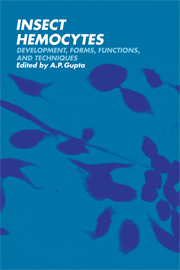Book contents
- Frontmatter
- Contents
- Preface
- List of contributors
- Part I Development and differentiation
- Part II Forms and structure
- 4 Hemocyte types: their structures, synonymies, interrelationships, and taxonomic significance
- 5 Surface and internal ultrastructure of hemocytes of some insects
- 6 Fine structure of hemocyte membranes and intercellular junctions formed during hemocyte encapsulation
- 7 Controversies about the coagulocyte
- 8 Controversies about hemocyte types in insects
- 9 Hemocyte cultures and insect hemocytology
- 10 Pathways and pitfalls in the classification and study of insect hemocytes
- Part III Functions
- Part IV Techniques
- Indexes
10 - Pathways and pitfalls in the classification and study of insect hemocytes
Published online by Cambridge University Press: 04 August 2010
- Frontmatter
- Contents
- Preface
- List of contributors
- Part I Development and differentiation
- Part II Forms and structure
- 4 Hemocyte types: their structures, synonymies, interrelationships, and taxonomic significance
- 5 Surface and internal ultrastructure of hemocytes of some insects
- 6 Fine structure of hemocyte membranes and intercellular junctions formed during hemocyte encapsulation
- 7 Controversies about the coagulocyte
- 8 Controversies about hemocyte types in insects
- 9 Hemocyte cultures and insect hemocytology
- 10 Pathways and pitfalls in the classification and study of insect hemocytes
- Part III Functions
- Part IV Techniques
- Indexes
Summary
Introduction
Like other cells, hemocytes are generally differentiated anatomically by differences in size and shape of the soma and nucleus; by type, number, size, and staining affinities of their inclusions; and by the general appearance and staining of the cytoplasm. They can also be distinguished by inherent behavioral differences in their ability to divide, in speed of degranulation (or vacuolization) of their inclusions, in their general cytoplasmic fragility, by the development (and types) of pseudopodia (or surface extensions), and by their tendencies to stick to each other or to different surfaces. They may also be classed according to their relative abundance at specific periods during the life span of a given species. Finally, hemocytes may be identified with some definite activity, such as phagocytosis, coagulation of the hemoplasma, or trephocytosis (Jones, 1962, 1964, 1977).
Hemocytopoiesis
The pitfalls in this area of insect hematology are particularly numerous. They begin with the acceptance of an imprecise vertebrate terminology. Because the words “hemopoiesis,” “hematopoiesis,” and “hematogenesis” all refer to the production or formation of blood (Dorland, 1974), they can refer to the formation of both the liquid fraction (plasma and lymph) and the formed elements (erythrocytes and leucocytes). Because insects have a combination of blood and lymph (hemolymph) and because they do not have red blood cells, it is better to use the word “hemocytopoiesis” to refer specifically to the formation of hemocytes (Jones, 1970) and to coin some other word, like “hemoplasmopoiesis,” to refer only to the formation of the liquid fraction of the hemolymph – hemoplasma. Hemolymph includes the hemoplasma and its indigenous cells, the hemocytes.
- Type
- Chapter
- Information
- Insect HemocytesDevelopment, Forms, Functions and Techniques, pp. 279 - 300Publisher: Cambridge University PressPrint publication year: 1979
- 7
- Cited by



